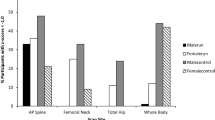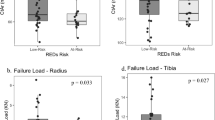Abstract
Although the female athletic triad is widely recognized clinically, there have been few studies quantitating the effect of disordered eating on bone mineral density. The purpose of this study was to explore the mechanisms through which disordered eating might influence the skeleton in nationally or internationally competitive runners. Fifty British national or higher standard middle and long-distance female runners aged under 36 years were recruited; 24 had amenorrhea (AM), nine had oligomenorrhea (OL) and the others were eumenorrheic (EU). Bone mineral density (BMD g.cm−2) of the proximal femur (femoral neck and trochanter) and lumbar spine (L2−L4) was measured by dual energy X-ray absorptiometry (DXA) and compared with population-based European reference data. Dietary eating patterns were assessed with the Eating Attitudes Test (EAT26) and Bulimia Investigatory Test Edinburgh (BITE) questionnaires. High eating disorder scores were common; the EAT26 score predicted menstrual disorders (P=0.014) and correlated with body mass index (BMI). BMD was generally low in the AM group, but was raised in the proximal femur in the EU group. In the AM group, younger age at start of training was associated with higher trochanteric BMD. In addition, years of eumenorrhea were positively associated with spine BMD. Although a high EAT26 score was associated with lower BMD in the proximal femur, this could be explained by the intermediary effect of menstrual disorders. Osteocalcin, a marker of bone formation, was reduced in the AM group and was also reduced by high VO2max and high BITE score, consistent with a central (hypothalamic) pathway for suppressing osteoblastic bone formation. Eumenorrheic runners had increased femoral BMD compared with European controls, consistent with a positive effect of increased mechanical loading. The effect of disordered eating to reduce BMD could be explained by its association with menstrual dysfunction. Lumbar spine BMD was reduced most in those athletes who menstruated for the shortest time in adolescence.



Similar content being viewed by others
References
Pirnay E, Bodeux M, Crielaard JM, Franchimont P (1987) Bone mineral content and physical activity. Int J Sports Med 8:331–335
Wolman RL, Clark P, McNally E, Faulmann L, Harries M, Reeve J (1990) Menstrual status and exercise are important determinants of spinal trabecular bone density in female athletes. BMJ 301:516–518
Drinkwater BL, Nilson K, Chesnut CH, Bremner WJ, Shainholtz S, Southworth MB (1984) Bone mineral content of amenorrhoeic and eumenorrhoeic athletes. N Engl J Med 311:277–281
McLean JA, Barr SI, Prior JC (2001) Dietary restraint, exercise and bone density in young women: are they related? Med Sci Sports Exerc 33:1292–1296
Otis CL, Drinkwater BL, Johnson M, Loucks A, Wilmore J (1997) The female athlete triad. Med Sci Sports Exerc 29:R1−R9
Nattiv A (2000) Stress fractures and bone health in track and field athletes. J Sci Med Sport 3:268–279
Nattiv A, Armsey TJ (1997) Stress Injury to bone in the female athlete. Clin Sports Med 16:197–224
De Cree C (1998) Sex steroid metabolism and menstrual irregularities in the exercising female. A review. Sports Med 25:369–406
Beals K, Manore M (2002) Disorders of the female athlete triad among collegiate athletes. Int J Sport Nutr Exerc Metab 12:281–293
Wilmore JH (1991) Eating and weight disorders in the female athlete. Int J Sport Nutr 1:104−117
Noble BS, Peet N, Stevens HY, Brabbs A, Mosley JR, Reilly GC, Reeve J, Skerry TM, Lanyon LE (2003) Mechanical loading: biphasic osteocyte survival and the targeting of osteoclasts for bone destruction in rat cortical bone. Am J Physiol Cell Physiol 284:934–944C
Noble BS, Reeve J (2000) Osteocyte function, osteocyte death and bone fracture resistance. Mol Cell Endocrinol 159:7–13
Tomkinson A, Reeve J, Shaw RW, Noble BS (1997) The death of osteocytes via apoptosis accompanies estrogen withdrawal in human bone. J Clin Endocrinol Metab 82:3128–3135
Zaman G, Pitsillides AA, Rawlinson SCF, Suswillo RLF, Mosley JR, Cheng MZ, Platts LAM, Hukkanen M, Polak JM, Lanyon LE (1999) Mechanical strain stimulates nitric oxide production by rapid activation of endothelial nitric oxide synthase in osteocytes. J Bone Miner Res 14:1123–1131
Stacey E, Korkia P, Hukkanen MV, Polak JM, Rutherford OM (1998) Decreased nitric oxide levels and bone turnover in amenorrhoeic athletes with spinal osteopenia. J Clin Endocrinol Metab 83:3056–3061
Durnin JVGA, Womersley J (1974) Body fat assessment from total body density and its estimation from skinfold thickness: measurements on 481 men and women aged from 16 to 72 years. Br J Nutr 32:77–97
Nelson M, Hague GF, Cooper C, Bunker VW (1988) Calcium intake in the elderly: validation of a dietary questionnaire. J Hum Nutr Diet 1:115–127
Garner DM, Olmsted MP, Bohr Y, Garfinkel PE (1982) The eating attitudes test: psychometric features and clinical correlates. Psychol Med 12:871–878
Henderson M, Freeman CPL (1987) A self-rating scale for bulimia. The BITE. Br J Psychiatry 150:18–24
Gibson JH, Harries M, Mitchell A, Godfrey R, Lunt M, Reeve J (2000) Determinants of bone density and prevalence of osteopenia among female runners in their second to seventh decades of age. Bone 26:591–598
Reeve J, Pearson J, Mitchell A, Green JR, Nicholls A, Justice J, Hudson E, Klenerman L (1995) Evolution of spinal bone loss and biochemical markers of bone remodelling after menopause in normal women. Calcif Tissue Int 57:105–110
Deacon AC, Hulme P, Hesp R, Green JR, Tellez M, Rinsler MG, Reeve J (1987) Estimation of whole body bone resorption rate: a comparison of urinary total hydroxyproline excretion with two radioisotopic tracer methods in osteoporosis. Clin Chim Acta 166:297–306
Wand JS, Green JR, Hesp R, Bradbeer JN, Sambrook PN, Smith T, Hampton L, Zanelli JM, Reeve J (1992) Bone remodelling does not decline after menopause in vertebral fracture osteoporosis. Bone Miner 17:361–375
Reeve J, Hesp R, Wootton R (1976) A new tracer method for the calculation of rates of bone formation and breakdown in osteoporosis and other generalised skeletal disorders. Calcif Tiss Res 22:191–206
Zanker CL, Swaine IL (1998) Relation between bone turnover, oestradiol and energy balance in women distance runners. Br J Sports Med 32:167–171
Creighton DL, Morgan AL, Boardley D, Brolinson PG (2001) Weight−bearing exercise and markers of bone turnover in female athletes. J Appl Physiol 90:565–570
Heinrich CH, Going SB, Pamenter RW, Perry CD, Boyden TW, Lohman TG (1990) Bone mineral content of cyclically menstruating female resistance and endurance trained athletes. Med Sci Sports Exerc 22:558–563
Snead DB, Weltman A, Weltman JY, Evans WS, Veldhuis JD, Varma MM, Terates CD, Dowling EA, Rogol AD (1992) Reproductive hormones and bone mineral density in women runners. J Appl Physiol 72:2149–2156
Wolman RL, Faulmann L, Clark, Hesp R, Harries MG (1991) Different training patterns and bone mineral density of the femoral shaft in elite, female athletes. Ann Rheum Dis 50:487–489
Marcus R, Cann C, Madvig P, Minkoff J, Gaddard M, Bayer M, Martin M, Gaudiani L, Haskell W, Genant H (1985) Menstrual function and bone mass in elite women distance runners. Ann Int Med 102:158–163
Drinkwater B, Nilson K, Chesnut C, Bremner W, Shaiholtz S, Southworth M (1984) Bone mineral content of amenorrhoeic and eumenorrhoeic athletes. N Engl J Med 311:277–281
Drinkwater BL, Bruemner B, Chesnut CH (1990) Menstrual history as a determinant of current bone density in young athletes. JAMA 263:545–548
Myerson M, Gutin B, Warre MP, Wang J, Lichtman S, Pierson RN (1992) Total body bone density in amenorrhoeic runners. Obstet Gynaecol 79:973–978
Barr SI, Petit MA, Vigna YM, Prior JC (2001) Eating attitudes and habitual calcium intake in peripubertal girls are associated with initial bone mineral content and its change over 2 years. J Bone Miner Res 16:940–947
Wolman RL, Clark P, McNally E, Harries MG, Reeve J (1992) Dietary calcium as a statistical determinant of spinal trabecular bone density in amenorrhoeic and normal menstrual status athletes. Bone Miner 17:415–423
Drinkwater BL, Nilson K, Ott S, Chesnut CH (1986) Bone mineral density after resumption of menses in amenorrhoeic athletes. JAMA 256:380–382
Lindberg JS, Powell M, Hunt MM, Ducey DE, Wade CE (1987) Increased vertebral bone mineral in response to reduced exercise in amenorrhoeic runners. West J Med 146:39–42
Karsenty G (2001) Leptin controls bone formation through a hypothalamic relay. Recent Prog Horm Res 56:401–415
Hilton LK, Loucks AB (2000) Low energy availability, not exercise stress, suppresses the diurnal rhythm of leptin in healthy young women. Am J Physiol Endocrinol Metab 278:E43−E49
Author information
Authors and Affiliations
Corresponding author
Rights and permissions
About this article
Cite this article
Gibson, J.H., Mitchell, A., Harries, M.G. et al. Nutritional and exercise-related determinants of bone density in elite female runners. Osteoporos Int 15, 611–618 (2004). https://doi.org/10.1007/s00198-004-1589-2
Received:
Accepted:
Published:
Issue Date:
DOI: https://doi.org/10.1007/s00198-004-1589-2




